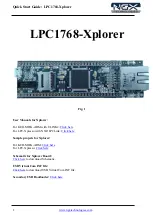
Altera Corporation
Reference Manual
2–39
May 2007
Nios Development Board Cyclone II Edition
Board Components
User Configuration
The user configuration partition is 1 MB, starting at offset 0x00C00000.
This section contains the FPGA configuration data for the user
configuration. Nios II development tools include documentation on how
to create your own user configuration image and program it into flash
memory.
Factory Configuration
The factory configuration partition is 1 MB, starting at offset 0x00E00000.
This section contains the FPGA configuration data for the factory
configuration. The Nios II processor system in the factory configuration
is designed to start executing code from offset 0x00000000 in the flash
memory. The Nios II development tools include the source files for the
factory programmed hardware and software reference designs.
Persistent Data
The persistent data partition is 64 KB, starting at offset 0x00FF0000. This
partition is for maintaining nonvolatile settings and data, such as the
MAC address and IP address for the factory-programmed web server
reference design. Persistent data is technically no different than other
application data, but it is often convenient to think of certain data as
independent from the user hardware or software.
JTAG Connectors
(J24 & J5)
The Nios development board has two 10-pin JTAG headers (J24 and J5)
compatible with Altera download cables, such as the USB-Blaster™. On
the Nios development board, each JTAG header connects to one Altera
device and forms a single-device JTAG chain. J24 connects to the FPGA
(U62), and J5 connects to the EPM7256AE device (U3).
JTAG Connector to FPGA (J24)
J24 connects to the JTAG pins (TCK, TDI, TDO, TMS, TRST) of the FPGA
(U62) as shown in
. Altera Quartus II software can directly
configure the FPGA with a new hardware image via an Altera download
cable as shown in
. In addition, the Nios II IDE can access the
Nios II processor JTAG debug module via a download cable connected to
the J24 JTAG connector.











































